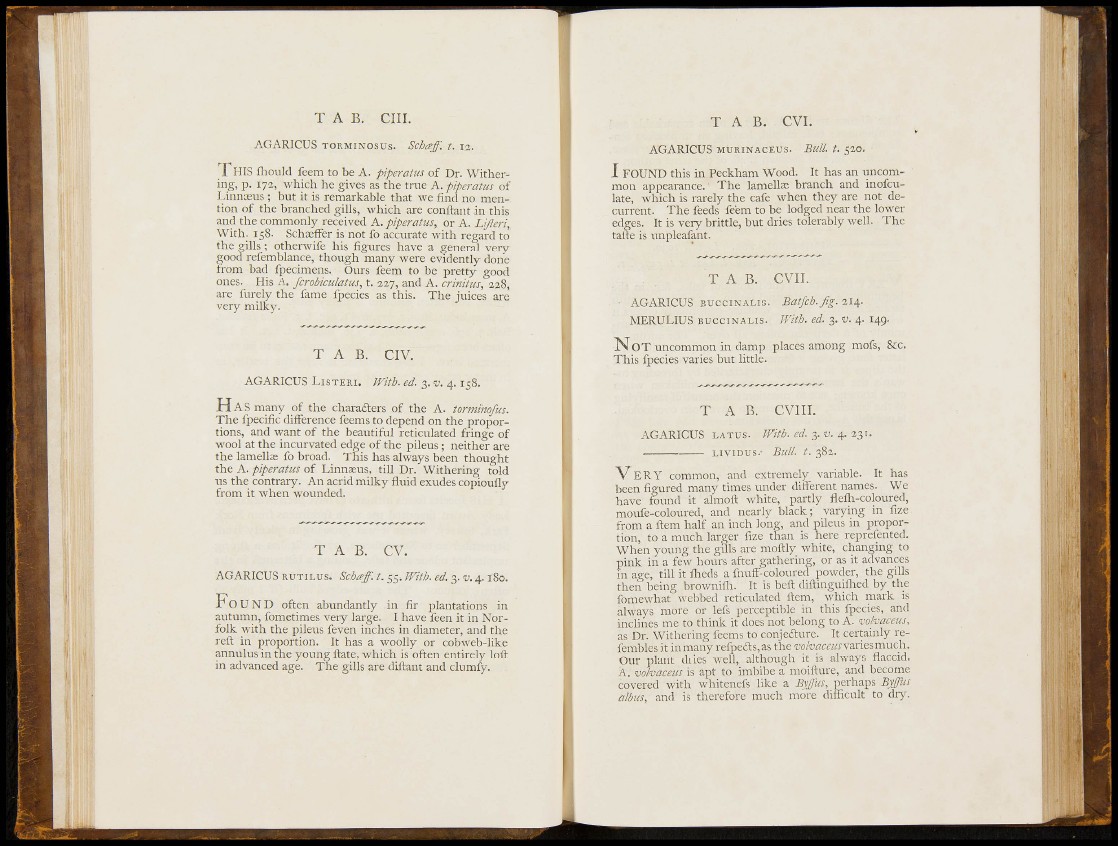
<
IS-.
TAB. cm.
AGARICUS TORMINOSUS. Scba-f. t. 12.
T H I S lliould feem to be A. piperatus of Dr. Witheiing,
p. 173, which he gives as the true A. piperatus of
Linnaeus ; but it is remarkable that we find no mention
of the branched gills, which are conftant in this
and the commonly received A. piperatus, or A. Lijieri,
With. 158. Scha^ffer is not fo accurate with regard to
the gills ; otherwife his figures have a general very
good refemblance, though many were evidently done
from bad fpecimens. Ours feem to be pretty good
ones. His II. Jcrobiculatus, t. 227, and A. crinitus, 228,
are furely the fame ipecies as this. The juices are
very milky.
T A B . CIV.
AGARICUS LISTERI. With. ed. 3. v. 4. 15S.
H AS many of the charadlers of the A. torjninofus.
The fpecific difference feems to depend on the proportions,
and want of the beautiful reticulated fringe of
wool at the incurvated edge of the pileus; neither are
the lamellae fo broad. This has always been thought
Vcit A. piperatus oi Linnasus, till Dr.'Withering told
us the contrary. An acrid mi lky fluid exudes copioufly
from it when wounded.
T A B . CV.
AGARICUS RUTILUS. Schifff. t. 55. With. ed. 3. v. 4.180.
F o UND often abundantly in fir plantations in
autumn, fometimes very large. I have feen it in Norfolk
with the pileus feven inches in diameter, and the
reft in proportion. It has a woolly or cobweb-like
annulus in the young ftate, which is often entirely loft
in advanced age. The gills are diftant and clumfy.
T A B . CVI.
AGARICUS MURINACEUS. Bull. t. 520.
I FOUND this in Peckham Wood. It has an uncommon
appearance. The lamella: branch and inofculate,
which is rarely the cafe when they are not decurrent.
The feeds feem to be lodged near the lower
edges. It is very brittle, but dries tolerably well. The
tafte is unpleafant.
T A B . CVII.
^ AGARICUS BUCCINALIS. Batjch.fig. 214.
MERULIUS BucciNALis. With. ed. 3. v. 4. 149.
N O T uncommon in damp places among mofs, &:c.
This fpecies varies but little.
T A B. CVIII.
AGARICUS LATUS. With. ed. 3. v. 4. 231.
LIVIDUS." Bull. t. 382.
V ERY common, and extremely variable. It has
been figured many times under different names. We
have found it almoft white, partly fleflr-coloured,
moufe-coloured, and nearly black; varying in fize
from a item half an inch long, and pileus in proportion,
to a much larger fize than is here reprefented.
When young the gills are nioftly white, changing to
pink in a few hours after gathering, or as it advances
in age, till it flieds a fnuif-coloured powder, the gills
then being browniflr. It is beft diftinguiflred by the
fomewhat webbed reticulated ttem, which mark is
always more or lefs perceptible in this fpecies, and
inclines me to think it does not belong to A. lohaceus,
as Dr. Withering feems to conjefture. It certainly refembles
i t in many refpefls, as the vohaceus varies much.
Our plant dries well, although it is always flaccid.
A. vohaceus is apt to imbibe a moifture, and become
covered with whitenefs like a Byjfus, perhaps Byffus
albus, and is therefore much more diflicult to dry.
1?.
:M